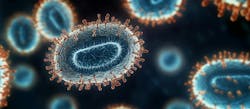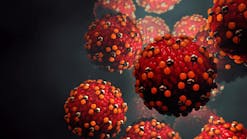This month, we introduce our newest “Tips” expert: Nicholas M. Moore, MS, MLS(ASCP)CM. Mr. Moore serves as Assistant Director of Clinical Microbiology and Assistant Professor at Rush University Medical Center in Chicago. He is responsible for the education of medical students, pathology residents, and infectious disease fellows related to clinical microbiology. He is actively engaged in clinical research funded through the Centers for Disease Control and Prevention (CDC) related to the rapid identification of multidrug resistant organisms and controlling the spread of these organisms in healthcare settings.
Q
I have just moved to a new hospital. On the vaginal wet prep, we have only three reportable parameters: yeast cells, clue cells, and trichomonas vaginalis—but not white blood cells (WBCs). Do you think that in not reporting WBCs we are leaving out an important parameter for diagnosing vaginitis?
A
Vaginitis is a general term that refers to a myriad of disorders of the vagina that may be due to infection, inflammation, or other causes that lead to changes of the vaginal microbiota. The most common symptoms include a malodorous discharge, itching, changes in urinary frequency, and general discomfort. Commonly, vaginitis is due to infection with Candida spp. or Trichomonas vaginalis, which when combined account for more than 90 percent of cases.1
Because these symptoms are non-specific, women who develop these symptoms should be evaluated by a clinician. The evaluation should include a pelvic examination and some limited diagnostic studies to determine the cause. Saline wet mounts are often used in approaches to provide diagnostic evidence for vaginitis in symptomatic women. A sample of vaginal discharge is collected with a vaginal/cervical scraper or a cotton-tipped swab. The sample is mixed with a few drops of 0.9 percent saline on a slide, coverslipped and examined using light microscopy. Normal vaginal discharge should reveal a predominance of squamous epithelial cells, rare polymorphonuclear leukocytes (PMNs), and Lactobacillus spp. The laboratorian is checking for the appearance of budding Candida spp. hyphae, T. vaginalis, clue cells, or increased PMNs, as these are characteristics of bacterial vaginosis (BV).
In my laboratory, we report the Nugent score, which takes into account the average number of morphotypes of bacteria, including Lactobacillus, Gardnerella/Bacteroides, and curved Gram-negative bacilli. We report and semi-quantitate the presence of PMNs, yeast, and clue cells as rare, few, moderate, or many. We perform a separate Trichomonas antigen test; for the majority of our patients both tests are ordered.
I think the presence of WBC may be helpful, but if your laboratory is using only the Amsel criteria, reporting WBC is not one of the parameters. The Amsel criteria includes production of a grey-white discharge, increased vaginal pH >4.5, positive whiff-amine test, and/or >20 percent of observed epithelial cells seen are clue cells.2 In one study of 640 women evaluated for BV, observation of clue cells was the most reliable diagnostic finding to predict BV.3
REFERENCES
- Sobel JD. Vulvovaginitis in healthy women. Compr Ther. 1999;25(6-7):335-346.
- Landers DV, Wiesenfeld HC, Weine RP, Krohn MA, Hiller SL. Predictive value of the clinical diagnosis of lower genital tract infection in women. Am J Obstet Gynecol. 2004; 190(4):1004-1010.
- Eschenbach DA, Hillier S, Critchlow C, Stevens C, DeRouen T, Holmes KK. Diagnosis and clinical manifestations of bacterial vaginosis. Am J Obstet Gynecol. 1988;158(40)819-828.
Q
Our doctors request strep group A culture on throat specimens which are negative for rapid strep group A testing. On culture workup, if we have beta hemolytic strep, we perform latex grouping only for GAS and report negative for GAS if latex is negative and positive if latex is positive. I think we should confirm all GAS with PYR, and also should group and report other non-GAS. What is your take on this?
A
Throat culture continues to be the recommended standard to diagnose exudative pharyngitis caused by group A strep (Streptococcus pyogenes).1 Throat cultures have a reported sensitivity between 90 percent and 95 percent.2,3 However, most labs first rely on a rapid test directly from a throat swab. Many commercial rapid antigen tests have specificities ≥95 percent, but sensitivities can vary from 65 percent to 90 percent.2-6
Because of this decreased sensitivity, it is recommended and best practice to perform a culture on all negative rapid strep tests. A variety of other organisms can also cause pharyngitis in children and adults (Table 1). For example, pharyngitis caused by Arcanobacterium haemolyticum can have a similar clinical syndrome as group A strep, including fever, exudative pharyngitis, and accompanying rash.7
Because of the high specificity of most commercial latex kits, I don’t think it is necessary to confirm PYR on a beta hemolytic strep isolate. I do think it is important, though, that other beta hemolytic strep colonies that grow but test negative for group A be tested with reagents to groups C and G, as these have also been reported to cause pharyngitis. Depending on the local epidemiology or in certain scenarios, the presence of other organisms could be responsible for a patient’s condition and should not be ignored.
REFERENCES
- Bisno AL. Acute pharyngitis. N Engl J Med. 2001;344(3):205-211.
- Shulman ST, Bisno AL, Clegg HW, et al. Clin Infect Dis. 2012;15(55):e86-102.
- Gerber MA. Comparison of throat cultures and rapid strep tests for diagnosis of streptococcal pharyngitis. Pediatr Infect Dis J. 1989;8(11):820-824.
- Dagnelie CF, Bartelink ML, van der Graaf Y, Gossens W, de Melker RA. Towards a better diagnosis of throat infections (with group A beta-haemolytic streptococcus) in general practice. Br J Gen Pract.1998;48(427):959-962.
- Gerber MA, Shulman ST. Rapid diagnosis of pharyngitis caused by group A streptococci Clin Microbiol Rev. 2004;17(3):571-580.
- Tanz RR, Gerber MA, Kabat W, Rippe J, Seshadri R, Shulman ST. Performance of a rapid antigen-detection test and throat culture in community pediatric offices: implications for management of pharyngitis. Pediatrics. 2009;123(2):437-444.
- Carlson P, Renkonen OV, Kontiainen S. Arcanobacterium haemolyticum and streptococcal pharyngitis. Scand J Infect Dis. 1994; 26(3): 283-287.





